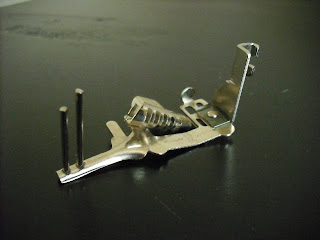Oh, how I was hoping that this would be the perfect garment to wear for Sunday brunch at my favorite Mexican restaurant. Sadly, no. It won’t be.
With this one, I was stepping outside of my trusted boundary of basics. The goal was to create a stylish, feminine yet comfortable top. Fail.
There is nothing that can be done (that I want to do) to salvage this thing. I didn't bother to cut it down a size as the only differences were the shoulder seams (which had already been shortened) and the armscyes, sleeve caps and side seams. Those could be adjusted to fit later. Anyway, making those seams smaller will not correct the sagging and the too-large neckline.
I've tried it on and was unable to get it to hang properly. I adjusted and smoothed out the fabric, then smiled at myself in the mirror - well, because I
do like the fabric. But, soon as I moved, it drooped again. I've been told that repetition is the mother of perfection. Repetition didn't help. Nor did smiling into the mirror.
Rescue efforts began by pinning the layers together at the front bodice seams. They were to be joined by topstitching to hopefully minimize the drooping. A positive move, but once back on the dress form, the tunic didn't cooperate any better than it had on me. And, that neckline cannot be overcome. Well, not without a major overhaul.
Usually, I interface and/or insert twill tape into a bias edge. The pattern instructions had it finished only with bias tape. I have been known to ignore printed pattern instructions and, so far, the pattern police have stayed away. So, I am not sure what I was thinking when I didn't include a stabilizer here.
Cleary, this edge needs to be stabilized more than what a bias strip offers. Bias edge plus bias strip equals the promise of stretching and lots of it. Including a narrow strip of interfacing, hidden by the bias strip, or twill tape, caught in the seam, would have helped. But I think that the neck edge would still not lay flat. The fabric isn't stretchy, but it
is drapey. Can I blame the fabric? Being not so thrilled with the style, I am unwilling to surrender more fabric in order to find out.
It doesn't look so bad from the front. Turn the dress form sideways, though, and you see the source of my disappointment. How do you fix this?
To tighten the neckline, a piece of elastic could be run between the outer neckline and the bias binding - and probably cause more ripples and pulls. Alternatively, small darts or tucks could be sewn around the neckline edge. But that would, I think, just look ugly. The neckline could be torn apart, the twill tape stitched on and the neckline pieces then rejoined with the expectation that all will be well. No. Don't think so. If the side didn't look so bad, I would consider getting out the seam ripper. But, no. Not gonna happen.
The 403A was not at fault. It performed well, very well indeed. I didn’t realize, however, how much I depend on the stitch-in-the-ditch presser foot for understitching and topstitching. I haven’t seen vintage ones available for slant-footed Singers, though that could mean that I just haven't looked in the right place. New ones that would fit are offered on various sewing/quilting websites. I don’t care whether it is old or new – only that it works.
The tunic has joined my other fabrics destined for muslin use.





































